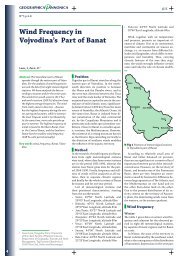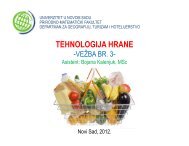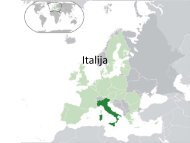Petrovaradin Fortress (Novi Sad, Serbia): Tourism Spatial Planning ...
Petrovaradin Fortress (Novi Sad, Serbia): Tourism Spatial Planning ...
Petrovaradin Fortress (Novi Sad, Serbia): Tourism Spatial Planning ...
Create successful ePaper yourself
Turn your PDF publications into a flip-book with our unique Google optimized e-Paper software.
Cultural tourism<br />
When we speak about the sustainability of one destination, it should be emphasized that it<br />
represents its capability, that it keeps the quality of its physical, social and cultural environment<br />
while at the same time it competes with its own products on the market (Ritchie,<br />
Crouch, 2003). The concept of sustainable tourism is based on three supporting columns<br />
of sustainable development, which were defined and recommended by the World Tourist<br />
Organization. These are: sustainability of economic, cultural and natural surrounding.<br />
World Tourist Organization states and warns that the development of sustainable tourism is<br />
possible only if all the relevant factors are thoroughly informed and included in the process.<br />
On the other hand, sustainable tourism must maintain the high level of tourist satisfaction,<br />
provide consciousness of the surrounding and lead active promotion of sustainable tourism<br />
(Mihalič, 2006).<br />
Previously mentioned factors refer to one new category of sustainability and that is the<br />
concept of supporting capacity. It gathers all ideas of sustainable development of tourism<br />
and appears as the unique function of sustainable development. That means that supporting<br />
capacity can be observed as well as the maximum number of visitors who use certain area<br />
without any negative consequences and decline in the quality of tourist experience (Mathieson,<br />
Wall, 1982). Consequently, supporting capacity represents the mean in the organization<br />
of tourism that, by the reduction in the number of tourists, prevents endangering of natural<br />
and cultural values of one tourist destination (Stojanović, 2006). Supporting capacity is<br />
manifested through four capacities that define certain segments of the sustainability of one<br />
entity. These segments are so elemental that must represent the base for every long-term plan<br />
of tourist development in certain area or destination. The supporting capacities are the following:<br />
ecological, social, psychological and economical (Jovičić, Dragin, 2008).<br />
If tourism is developed according to a plan in certain area, it can not have a negative influence<br />
on the space but can only encourage the actions aimed at protecting natural and anthropogenic<br />
values that it valorises (Stanković, 1991) and more than other activities avoids collisions<br />
and encourages elements of complementary development (Stanković, 1996). <strong>Tourism</strong><br />
should educate, promote and raise interest among tourists in the space they visit and at the<br />
same time promote responsibility and raise conscious of sustainability in general. It is necessary<br />
to emphasize that tourism represents educational component of this type of tourism is<br />
its key aspect and that tourist are keen on learning, seeing, doing and participating (Vistoria,<br />
2006). It is cultural tourism that is recognized as a new market and a new form of tourism<br />
that remains forever (Richards, 2001), as a special interest in tourism itself (Douglas and<br />
Derrett, 2001) and as a special market niche with growing demand (Jansen-Verbeke, 1996).<br />
This is how cultural tourism is used, apart from the other, for positive promotion of culture<br />
and cultural heritage (Light, 2000). Consequently, this kind of interacting relationship<br />
between culture and tourism brings a wide correlation and mutual interest that is confirmed<br />
with the creation of extra income in favour of both the activities and causes sustainability<br />
and promotion of cultural resources that would otherwise disappear (Hughes, 2000). The<br />
important fact is that cultural tourism represents a widely spread phenomenon and activity<br />
that creates conditions for a wide range of activities. Cultural tourism protects cultural heritage,<br />
promote it (Çalışkan, 2010) and places it in the function of different musical, dance<br />
or theatre events (Hughes, 1998). The importance of cultural heritage as a tourist destina-<br />
68 TURIZAM | Volume 15, Issue 2, 65-76 (2011)
















